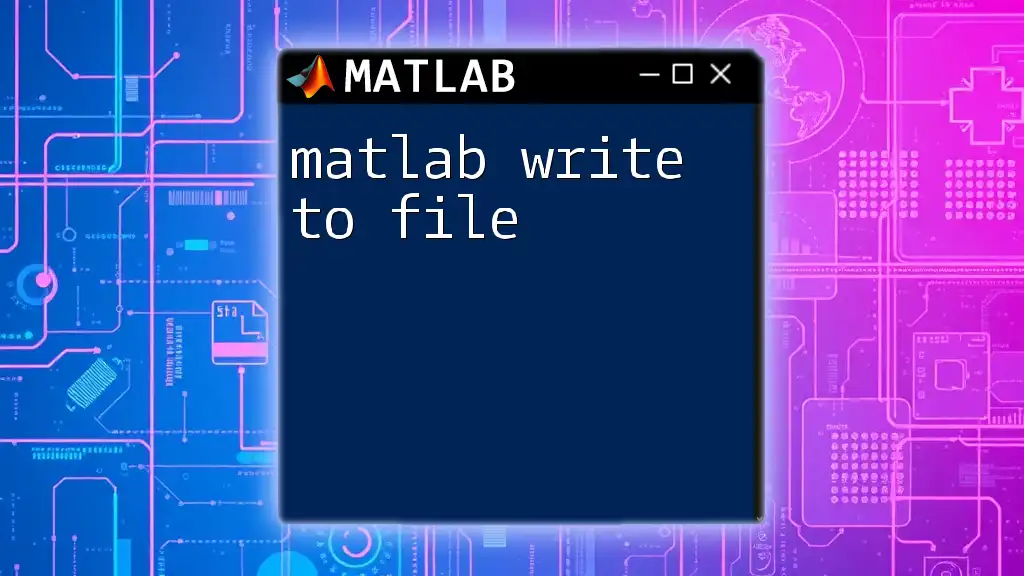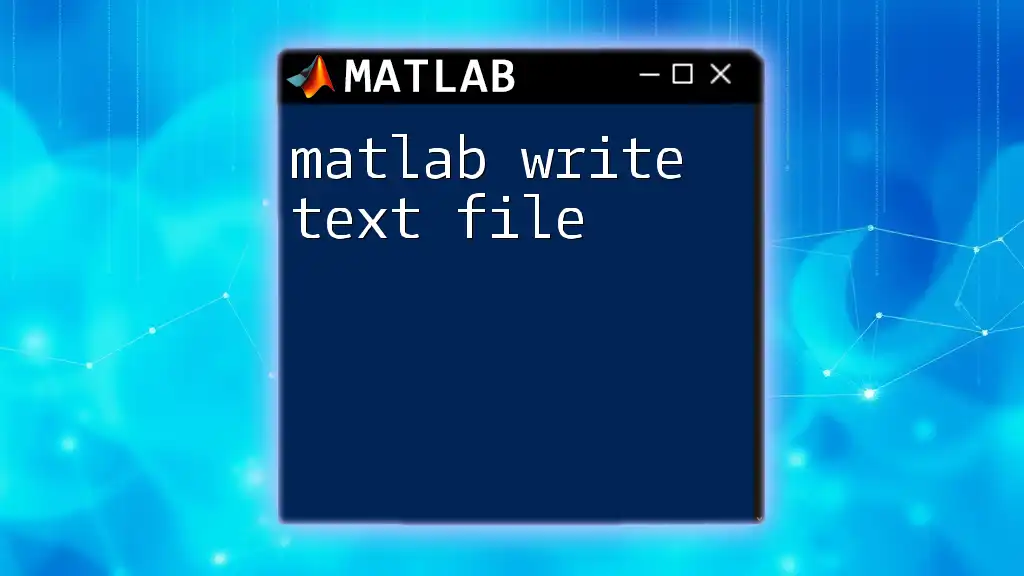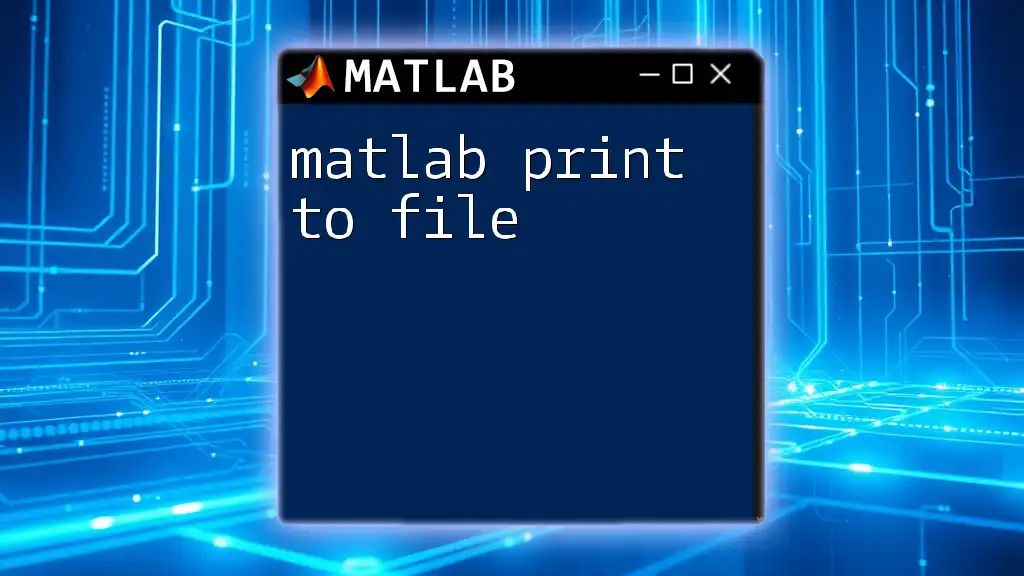In MATLAB, you can easily write data to an Excel file using the `writetable` function to export a table as follows:
data = table([1; 2; 3], ['A'; 'B'; 'C'], 'VariableNames', {'Numbers', 'Letters'});
writetable(data, 'output.xlsx');
Understanding the Basics of Writing to Excel in MATLAB
What is the `xlswrite` function?
The `xlswrite` function in MATLAB is a fundamental tool used for exporting data to Excel files, specifically in the XLS and XLSX formats. This function allows users to write numeric and text data directly to Excel spreadsheets.
Syntax Overview: The basic syntax for `xlswrite` is as follows:
xlswrite(filename, data, sheet, range)
- `filename`: The name of the Excel file to which you want to write (e.g., 'data.xlsx').
- `data`: The data to be written, which can be a matrix, cell array, or table.
- `sheet`: Optional; specifies the sheet name.
- `range`: Optional; specifies a range within the sheet where the data will be placed.
It's essential to note that `xlswrite` may not work on all platforms, as it relies on Microsoft Excel being installed on the system.
When to Use the `writetable` Function
With the advent of newer MATLAB versions, the `writetable` function has become increasingly recommended for data export due to its flexibility. This function is specifically tailored to write tables to Excel, making it ideal for more complex data structures.
Why Choose `writetable`?
- Supports various data types, including tables and timetables.
- Automatically formats the data appropriately for Excel.
The basic usage syntax of `writetable` is:
writetable(T, filename)
Where `T` is the table you want to write and `filename` is the path to the output Excel file.

Step-by-Step Guide to Writing Data from MATLAB to Excel
Preparing Your Data
Before proceeding to write to Excel, it is vital to prepare the data correctly. MATLAB supports a variety of data types suitable for writing to Excel files, such as matrices, cell arrays, and tables.
For example, you might want to create a simple matrix and a table:
dataMatrix = rand(5); % Creates a 5x5 matrix of random numbers
dataTable = array2table(dataMatrix, 'VariableNames', {'A', 'B', 'C', 'D', 'E'});
In this example, the `dataMatrix` contains random values, while `dataTable` converts this matrix into a table format, complete with column headers.
Using `xlswrite` to Write Data to Excel
Basic Write Operation:
To perform a basic write operation using `xlswrite`, follow this syntax:
filename = 'myData.xlsx';
xlswrite(filename, dataMatrix);
Here, `dataMatrix` will be written to the workbook named `myData.xlsx`.
Specifying the Sheet and Cell Range:
You can specify both the sheet to write to and the cell range for data placement:
xlswrite(filename, dataMatrix, 'Sheet1', 'A1');
This command writes the `dataMatrix` starting from cell A1 on Sheet1 of the specified Excel file.
Example: Writing Multiple Ranges and Sheets:
To write data to different sheets or ranges, you can include multiple calls to `xlswrite`:
xlswrite(filename, dataMatrix, 'Sheet1', 'A1');
xlswrite(filename, rand(3,3), 'Sheet2', 'B2'); % Writes a 3x3 random matrix to Sheet2
Advanced Options with `writetable`
To harness the full power of writing tables to Excel, utilize the `writetable` function.
Basic Syntax of `writetable`:
To write the `dataTable` created earlier to an Excel file, you would use:
writetable(dataTable, 'myTableData.xlsx');
This line creates a new Excel file called `myTableData.xlsx` and writes `dataTable` into it.
Specifying Sheet Names and Ranges:
Additionally, you can specify a sheet name and a range where data should be placed:
writetable(dataTable, 'myTableData.xlsx', 'Sheet', 'Data', 'Range', 'A1');
In this command, `dataTable` will be written to the "Data" sheet, starting from cell A1.

Handling Formatting and Customization
Formatting Excel Cells Directly from MATLAB
For advanced users, MATLAB provides the ability to format Excel files directly using ActiveX server automation. You can access various Excel functionalities, allowing you to modify cell properties, such as font size, color, and style easily.
Initialization: To start using ActiveX server for Excel:
excel = actxserver('Excel.Application');
Example of Cell Formatting:
You can write and format your Excel file like this:
workbook = excel.Workbooks.Open(fullfile(pwd, 'myData.xlsx'));
sheet = workbook.Sheets.Item(1);
sheet.Range('A1:E1').Font.Bold = true; % Make the headers bold
workbook.Save();
workbook.Close();
excel.Quit();
In this example, after writing your data, the first row of the Excel sheet is formatted to appear bold.
Writing Different Data Types
MATLAB allows handling various data types—including strings, dates, and logical arrays—when writing to Excel. This versatility enables users to represent complex data efficiently.
Example with Mixed Data Types:
Suppose you have a mixture of numbers, strings, and dates:
mixedData = {1, 'value', true, now}; % Cell array containing different types
writetable(cell2table(mixedData), 'mixedData.xlsx');
This command converts the cell array `mixedData` into a table and writes it to a new Excel file, demonstrating how to handle diverse data types.

Common Errors and Troubleshooting
Issues with File Permissions
One common issue when using `matlab write to excel` is encountering file permission errors. This typically happens if the Excel file you are trying to write to is currently open or if the directory does not have write permissions. To resolve this:
- Ensure the file is closed before attempting to write.
- Check directory permissions and adjust them if necessary.
Data Format Issues
Another potential challenge arises from data format mismatches. Ensure that:
- The data types being written are compatible with Excel (e.g., no complex structures).
- MATLAB lists any additional warnings pertaining to data interpretation.

Conclusion
Writing data from MATLAB to Excel is a crucial skill for anyone involved in data analysis and reporting. Using functions like `xlswrite` and `writetable`, users can efficiently export data, customize outputs, and even tackle complex formatting tasks. By practicing the examples and techniques outlined in this guide, users can leverage the full potential of MATLAB’s data handling capabilities alongside Excel’s robust organizational functions.

Additional Resources
For further learning, explore the official MATLAB documentation on `xlswrite` and `writetable`. Consider diving deeper into specific MATLAB and Excel integration tutorials to enhance your skill set!

















